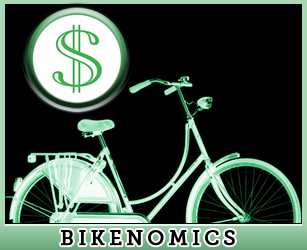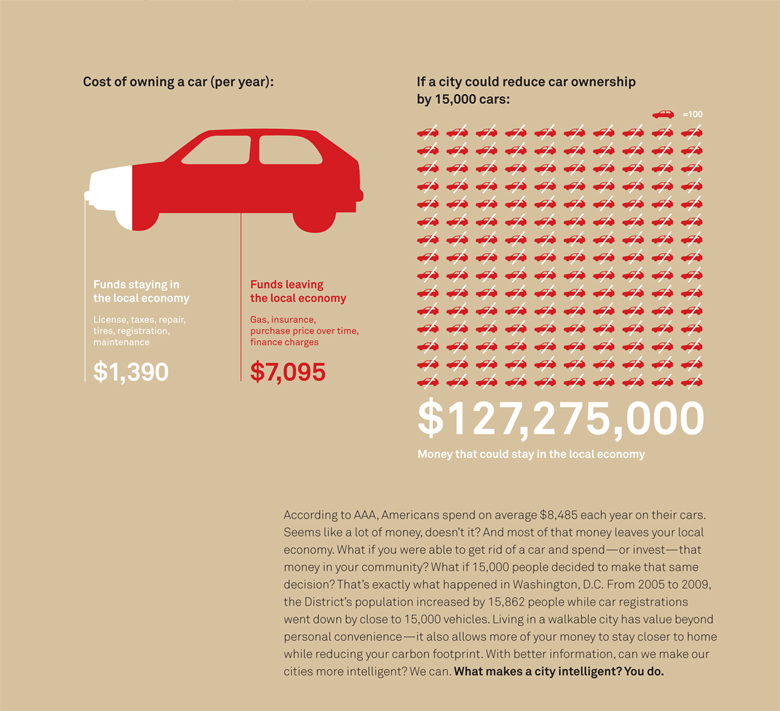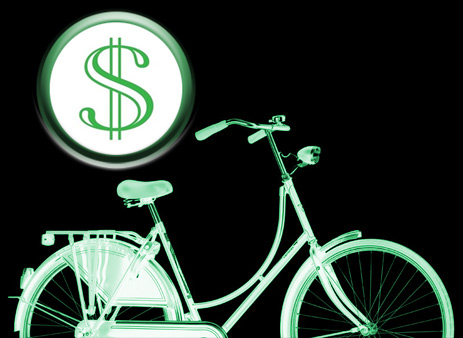 This is the first column in a series focusing on the economics of bicycling.
This is the first column in a series focusing on the economics of bicycling.
Imagine getting a $3,000 to $12,000 tax rebate this year. Now imagine it coming again and again. Every year it grows by around a thousand dollars.
Imagine how this would change your daily life.
Sounds like a teabagger’s wet dream, but it’s actually a conservative estimate of how much you’d save by ditching your car, or even just one of your cars — and getting on a bicycle instead.
Car-centric conditions don’t always make it easy to choose the bicycle. Communities designed exclusively for motor vehicles impose a major financial penalty on those who are compelled to take on the expense of driving. But if you’re one of those who lives in a bike-friendlier place, you’ll be doing your local business community a good turn and padding Uncle Sam’s pockets as well as your own if you trade four wheels for two.
In the many North American cities where two-wheeled transportation is taking off, a new bicycle economy is emerging. It’s amazing how much money can stay in your community when it isn’t being pumped into the gas tank, big insurance, and the auto market.
What will this new bicycle economy look like?
We don’t have to guess. It’s already emerging along urban, low-traffic bikeway networks nationwide. One thing is guaranteed: it includes a lot of new bike shops like this one on a bikeway in Baltimore — one of five new bike shops to have opened in the last two years in that city. A 2008 study in Portland clocked bicycle-related industry alone as contributing $90 million to the local economy every year. Bicycle tourism is another huge boon to regions that can attract it — in 2010, Wisconsin bragged of a yearly $1.5 billion bike economy [PDF].
Less obvious synergies abound as well. People who ride, just like people who drive, buy groceries, visit the doctor, need a new shirt sometimes, and enjoy dinner and a movie. They work. Their kids attend school. Despite the media attention given to mega-mileage supercommuters, for most people who depend on bikes for transportation, life works best with all these necessities in reasonable biking distance — say, less than five miles — from their home. Preferably along routes that don’t include riding on highways or having to zip anxiously across them.
Bicycle parking is the indicator species of this new economy, with a business’s enthusiasm for its two-wheeled clientele being easy to gauge by the quantity of bike racks out front. In Portland, businesses impatiently line up to replace their car parking with on-street bike racks. One local grocery store recently opened a location with more parking for bicycles than for cars.
Then there’s the food cart boom that’s overtaken Portland — every previously vacant alley and parking lot, many along major bike routes, seems to have spawned a semi-permanent pod of them. As a business model, it’s a natural response to a population that craves cheap lunch, prefers not to travel far, and doesn’t need a 7′ x 20′ piece of real estate to park on.
There are many more local benefits of the bike economy, from lowering families’ health care costs to reducing a business’s need to invest in costly parking spaces for staff and customers. And you can’t place a monetary value on happiness.
But as long as our local governments keep hearing strident resistance to rather than support for safe, bikeable and walkable streets, the bicycle economy will continue to be reined in — by inadequate infrastructure, terrible zoning, and giant road expansion projects of the sort that tie up all transportation funding for decades to come.
The bicycle economy, unlike its fancier cousin transit-oriented development, is not about new development or raising property values. It’s about bettering our existing communities. It’s about making cities and suburbs that are built on an automotive scale navigable, instead, by human power. It’s about providing the basics to everyone, in their neighborhood, now — and along with that the choice to opt for that $3,000 to $12,000 yearly rebate.
There aren’t very many economic scenarios in this country where everyone wins. But if you had to choose one single thing that could pull our neighborhoods, towns, and cities out of this murky pit of a recession, you’d do well to bet on the humble bicycle.
 Click for a larger version.Infographic: Mgmt Design, courtesy of the National Building Museum
Click for a larger version.Infographic: Mgmt Design, courtesy of the National Building Museum
Next: “Tearing down urban freeways to make room for a new bicycle economy.”

